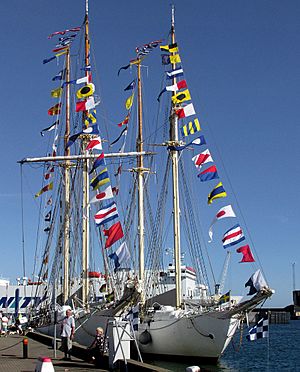Flag alphabet facts for kids
Ships have a special way to talk to each other without using radios! They use something called the flag alphabet, also known as signal flags. It's like a secret language made of colorful flags. Sailors use these flags to send messages from one ship to another, especially when they are far apart or need to communicate quickly and silently. This way of communicating is called optical signalling because it uses things you can see, like flags.
Contents
What is the Flag Alphabet?
The flag alphabet is a system where different flags stand for letters, numbers, or special messages. Imagine a big set of colorful flags, each with its own meaning. Ships use these flags to "talk" to each other across the water.
How Do Ships Use Flags to Talk?
There are a few main ways ships use these special flags:
- Spelling out words: Each flag can represent a letter of the alphabet. When sailors want to send a message, they hoist a series of flags, one after another, to spell out the words. It's like sending a very colorful text message!
- Single flag meanings: Sometimes, just one flag can send a whole message. For example, the "A flag" (which is white and blue) usually means "I have a diver down; keep clear at slow speed." This is super important for safety!
- Code messages: Several flags used together can form a special code. Both ships will have a "code book" that explains what each combination of flags means. This helps them send complex messages quickly without spelling out every single word.
- Racing signals: In ship races, flags have different meanings. They can tell racers when to start, when there's a problem, or if a race has been cancelled.
The International Code of Signals
The most common system for flag communication is the International Code of Signals (often called ICS). This code was created so that ships from different countries could understand each other, no matter what language they speak. It's like a universal language for the sea!
What Does the ICS Include?
The ICS has:
- 26 square flags, one for each letter of the alphabet.
- 10 pennants (triangle-shaped flags), one for each number from 0 to 9.
- 3 "substitute" or "repeater" pennants. These are used when you need to repeat a letter or number in a message without having another flag of the same kind.
- 1 answering pennant, which is used to acknowledge messages.
Each flag has a unique design and color, making it easy to tell them apart, even from far away.
Why is Flag Signalling Still Used?
Even with modern radios and satellites, flag signalling is still very important:
- Silent communication: Flags allow ships to communicate without making noise or giving away their position with radio signals.
- Backup system: If a ship's electronic equipment fails, flags can be used as a reliable backup.
- Tradition and ceremony: Flags are also used for traditions, like dressing a ship with all its flags for a special event or welcoming a visiting ship.
Related pages
Images for kids



